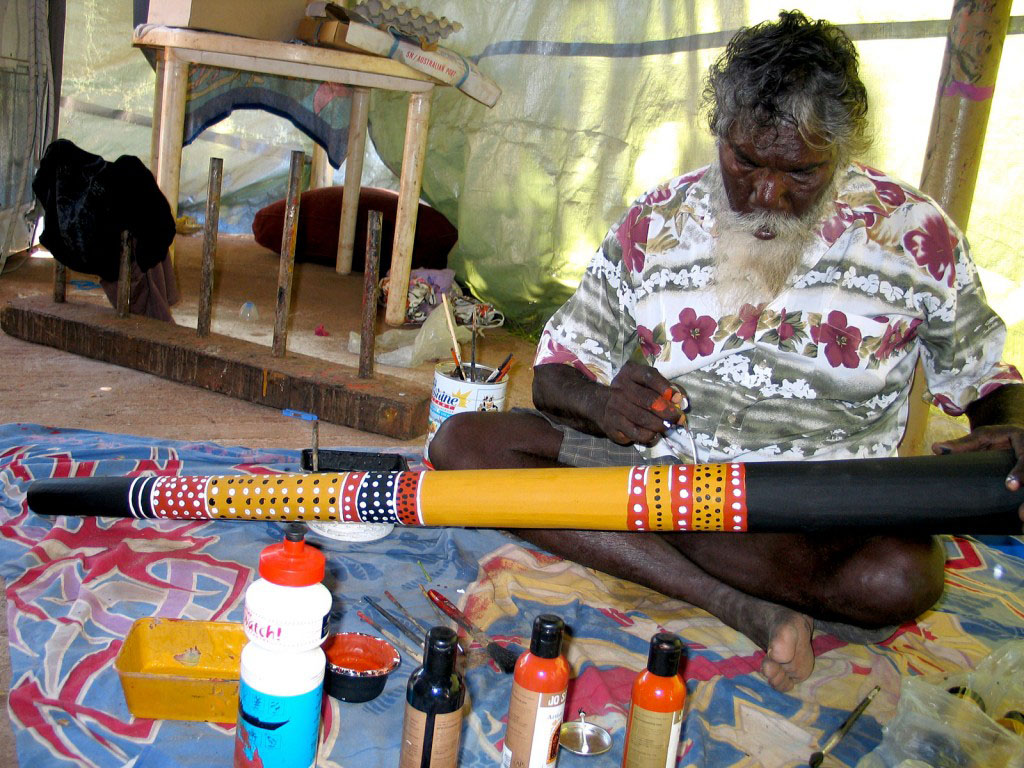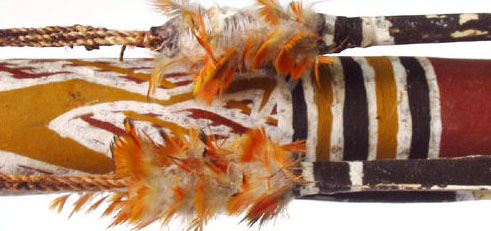.
 The overwhelming predominance of non-authentic didgeridoos in the global market, together with the widespread misrepresentation and mislabeling of instruments by non-Aboriginal craftsmen, manufacturers, wholesalers and retailers, is of major concern to iDIDJ Australia. Links in this section will bring you to accounts of the sacred origins of the didgeridoo, statements from a number of respected Aboriginal leaders, and an overview of trends in the didgeridoo industry. This promotes understanding of the different types of didgeridoos available. Examples of authentic instruments are shown as well as a variety of inauthentic instruments commonly found in retail shops.It is hoped this information would go some way towards protecting consumers from unethical retailers and unconscionable non-Indigenous didgeridoo makers.
The overwhelming predominance of non-authentic didgeridoos in the global market, together with the widespread misrepresentation and mislabeling of instruments by non-Aboriginal craftsmen, manufacturers, wholesalers and retailers, is of major concern to iDIDJ Australia. Links in this section will bring you to accounts of the sacred origins of the didgeridoo, statements from a number of respected Aboriginal leaders, and an overview of trends in the didgeridoo industry. This promotes understanding of the different types of didgeridoos available. Examples of authentic instruments are shown as well as a variety of inauthentic instruments commonly found in retail shops.It is hoped this information would go some way towards protecting consumers from unethical retailers and unconscionable non-Indigenous didgeridoo makers.

“We go along, making country… Going there, to where the white clouds are rising, our hips swaying… Step by step, we sing as we go, making the country… Shall we sit here? Shall we erect our shade here?”
Translation of a sacred song from north-east Arnhem Land, Yolngu language group.
Where did the didgeridoo come from? How did it first come into this world? Who were the first people who made and played it? Aboriginal people in Arnhem Land, in Australia’s remote Northern Territory, are recognised as the traditional owners or custodians of the didgeridoo. To the Yolngu people, for instance, there is a body of knowledge relating to the origins of the instrument that stretch far back into the ‘Dreamtime’ – when the world was first created. In this part of the world there exists deep sacred knowledge that is closely guarded by elders and by those who are vested with the authority to protect and maintain the religious life of the people.
Djalu Gurruwiwi, a senior member of the Galpu clan, is one such person. Djalu is fond of reminding didgeridoo players throughout the world of the special place the didgeridoo has in his culture. The didgeridoo is a totem, a symbol of identity and authority, and a musical instrument. In public ceremonies, the didgeridoo is played to accompany singing and the pattern of clapstick beats particular to each clan. In some secret ceremonies, a different sort of didgeridoo is brought out… only initiated men may view this special instrument and its inner secrets are only known by the most senior elders vested with maintaining the law. Transgression of the law carries serious penalties including death by sorcery.
 When the Ancestral Beings created the land, animals, plants and all other life forms, they also laid down a set of rules and regulations so that human beings could live within a system of law. The didgeridoo and its origins are part of this law… in this sense, the didgeridoo and its associated mythologies are the foundation blocks for life itself because the didgeridoo and its inner manifestations have their roots in Creation Stories much like the Book of Genesis in the Bible. Djalu is fond of saying that a didgeridoo made by a traditional owner or custodian has spirit. The spirit is in the instrument itself, a genealogy dating back to the first didgeridoo. An instrument made by a non-Indigenous person, on the other hand, has no spirit but is merely a musical instrument like a trumpet or a trombone. The same applies to didgeridoos made by Aboriginal people who do not have the instrument as part of their cultural heritage.
When the Ancestral Beings created the land, animals, plants and all other life forms, they also laid down a set of rules and regulations so that human beings could live within a system of law. The didgeridoo and its origins are part of this law… in this sense, the didgeridoo and its associated mythologies are the foundation blocks for life itself because the didgeridoo and its inner manifestations have their roots in Creation Stories much like the Book of Genesis in the Bible. Djalu is fond of saying that a didgeridoo made by a traditional owner or custodian has spirit. The spirit is in the instrument itself, a genealogy dating back to the first didgeridoo. An instrument made by a non-Indigenous person, on the other hand, has no spirit but is merely a musical instrument like a trumpet or a trombone. The same applies to didgeridoos made by Aboriginal people who do not have the instrument as part of their cultural heritage. As part of these processes I have come to recognise the ritual significance of the didgeridoo within indigenous society. Apart from all its other attributes, the didgeridoo is a work of art in itself: many are beautifully painted and indeed have been collected by major institutions devoted to the visual arts such as the National Gallery in Canberra and the Art Gallery of New South Wales. The ever increasing commercial interest in the didgeridoo has, to my mind, not been accompanied with any equivalent appreciation of the value of the instrument within Aboriginal society – not of its meaning nor of its symbolism. With years of working within Aboriginal communities behind them, iDIDJ Australia is well placed to provide and promote the educational context for the didgeridoo.
As part of these processes I have come to recognise the ritual significance of the didgeridoo within indigenous society. Apart from all its other attributes, the didgeridoo is a work of art in itself: many are beautifully painted and indeed have been collected by major institutions devoted to the visual arts such as the National Gallery in Canberra and the Art Gallery of New South Wales. The ever increasing commercial interest in the didgeridoo has, to my mind, not been accompanied with any equivalent appreciation of the value of the instrument within Aboriginal society – not of its meaning nor of its symbolism. With years of working within Aboriginal communities behind them, iDIDJ Australia is well placed to provide and promote the educational context for the didgeridoo.
As indigenous visual arts have become a powerful and effective ambassador for Aboriginal aspirations and achievements in the public domain, so too the didgeridoo – with an awareness of the cultural value of the instrument presented according to the objectives of iDIDJ Australia – can also fulfil such a crucial role”.
| The Didgeridoo in the Global Market: Part I | ||||
| The Didgeridoo in the Global Market: Part II | ||||
| The Didgeridoo in the Global Market: Part III | ||||
Every year, hundreds of thousands of didgeridoos are sold around the world. The sad thing about this is that less than 0.01% of these didgeridoos could be called authentic… even sadder is the fact that the didgeridoo industry is now worth millions of dollars and traditional Aboriginal custodians of the instrument hardly get to see a cent of it. iDIDJ Australia wants to do something about this and we would like you to help us!
Please read about the different types of didgeridoos available to understand their origins and cultural integrity. Whenever possible, we educate consumers in the benefits of supporting the traditional Aboriginal custodians of the didgeridoo. We strongly discourage consumers from spending their didgeridoo dollars on manufactured or mass-produced instruments which fall into the other categories. Note, however, that good quality product and ethical instrument makers can be found in these categories… many hobby craftsmen, in the USA and Europe for example, hand-make excellent quality didgeridoos from a variety of materials and methods and these can be purchased at a reasonable price.
These craftsmen – and you’ll find out who they are with some research – do not represent their creations as something they are not. Some mass-producers and manufacturers, on the other hand, are alleged to have breached trade practices laws by labelling their didgeridoos as authentic or Aboriginal-made when they clearly are not… and others have been caught illegally cutting and mass-harvesting trees without the proper permits… sometimes on Aboriginal lands!
Types of Didgeridoos
Authentic Traditional Aboriginal Didgeridoo
![]() High cultural integrity instrument. 100% made and decorated, from start to finish, by a traditional custodian of the instrument. A traditional custodian is an Indigenous Australian who is entitled, by Aboriginal tradition, to make and use the didgeridoo and whose ancestors, by Aboriginal tradition, have made and used the didgeridoo. Made from termite-hollowed eucalyptus and other naturally occurring materials that were traditionally used for didgeridoo construction. Remote areas of the Northern Territory especially Arnhem Land.
High cultural integrity instrument. 100% made and decorated, from start to finish, by a traditional custodian of the instrument. A traditional custodian is an Indigenous Australian who is entitled, by Aboriginal tradition, to make and use the didgeridoo and whose ancestors, by Aboriginal tradition, have made and used the didgeridoo. Made from termite-hollowed eucalyptus and other naturally occurring materials that were traditionally used for didgeridoo construction. Remote areas of the Northern Territory especially Arnhem Land.
Aboriginal Didgeridoo
![]() 100% made and decorated, from start to finish, by an Indigenous Australian who is not a traditional custodian of the instrument. Made from termite-hollowed Australian native timber, usually eucalyptus. Australia-wide.
100% made and decorated, from start to finish, by an Indigenous Australian who is not a traditional custodian of the instrument. Made from termite-hollowed Australian native timber, usually eucalyptus. Australia-wide.
Aboriginal Art Didgeridoo
![]() A didgeridoo that is only decorated by an Australian Aboriginal person, but made by a non-Indigenous producer. Australia-wide.
A didgeridoo that is only decorated by an Australian Aboriginal person, but made by a non-Indigenous producer. Australia-wide.
Australian Didgeridoo
![]() Any didgeridoo made and decorated (or left undecorated) by an Australian non-Indigenous producer from Australian termite-hollowed native timbers. Australia-wide
Any didgeridoo made and decorated (or left undecorated) by an Australian non-Indigenous producer from Australian termite-hollowed native timbers. Australia-wide
Didgeridoo
![]() All other didgeridoos other than those in categories above. These are made from a diversity of materials and methods in Australia and overseas. Australia & overseas.
All other didgeridoos other than those in categories above. These are made from a diversity of materials and methods in Australia and overseas. Australia & overseas.
